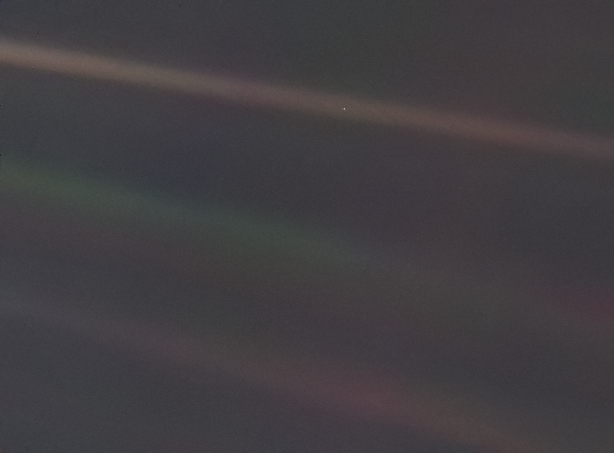The background picture is called the
Pale Blue Dot. It's
kind of a big deal.
For those of you too lazy to click the link (or whose internet connection
gave out immediately after loading this page), that picture was taken by the
Voyager 1 spacecraft. On
November 20, 1980 it left Saturn's orbit and, due to its speed and trajectory,
would not encounter Uranus or Neptune on its way out of the solar system. NASA
had intended to simply turn the ship outwards and take measurements of solar
wind as it turned into interstellar wind (a transition Voyager is measuring
now, incidentally), but nerd hero and noted greatest human being ever
Carl Sagan, after almost
10 years, convinced them to turn Voyager around and take one last photograph
of the Earth. The picture was scientifically useless, as the Earth only shows
up as a tiny blueish point, but the sheer insignificance of our planet against
the vastness of space is exactly what Sagan wanted to demonstrate. He knew
that Voyager was in a position no other probe had ever been in, and possibly
never would be, to give us the universe's perspective on ourselves, to show us
just how small and fragile we are, despite how important everything seems when
you look at it on the ground.
The 10 year delay, though not intended by Sagan, makes the photograph more
meaningful in my opinoion for two important reasons. The first is that in 1980
Voyager had just passed Saturn. That's very far away from home, to be sure,
but there are still two planets and a Pluto (whatever your stance on that
issue) before you get to the edge. In early 1990, when the picture was finally
taken, the Voyager probe was well beyond the orbit of Pluto. In 1980, Voyager
would have taken a picture of the Earth from "far away." In 1990, it took a
picture of the Earth from the edge of our solar system. It wasn't just far
away; it had crossed some invisible line that separates some concept of "home"
that we still cling to from some concept of "the rest of the universe" that we
still hide from. Voyager is the furthest man-made object ever, and will
continue to be unless we launch something to catch up to it, and this picture
is it looking back from the furthest frontier of human exploration and saying,
"That's home. That's where I came from."
The second reason the 10 year delay makes that photograph more meaningful
is a more personal one. Voyager 1's mission ended on November 20, 1980. 9
years later to the day, I was born. When Voyager took this picture, sometime
between February and June, I was between 3 and 6 months old. I'm in that
picture. That's me. When I'm feeling flippant about it, I like to say that
this picture is my favorite picture of me, but it's true. I'm among the
youngest people alive to be in that picture. Of course, at this vast distance,
it doesn't really matter who's in the picture and who's not. It's still a
picture representing the whole of human accomplishment as a fraction of a
pixel, no matter when it was taken. But the fact that I happen to be in that
fraction of a pixel, that I was there, makes me feel somehow more a part of
humanity, and makes me feel more at peace. Humans are wonderful and terrible
creatures, but looking at this picture keeps me from letting the terrible
parts paralyze me, and helps put the wonderful parts in perspective against
the infinite wonders of the universe that we can never match.
Aside from the bit about me being a baby in the picture, Carl Sagan said
pretty much everything I said, only infinitely more gracefully, so please
go read or listen to him. Like I said, he's pretty close to the best human
being ever.
